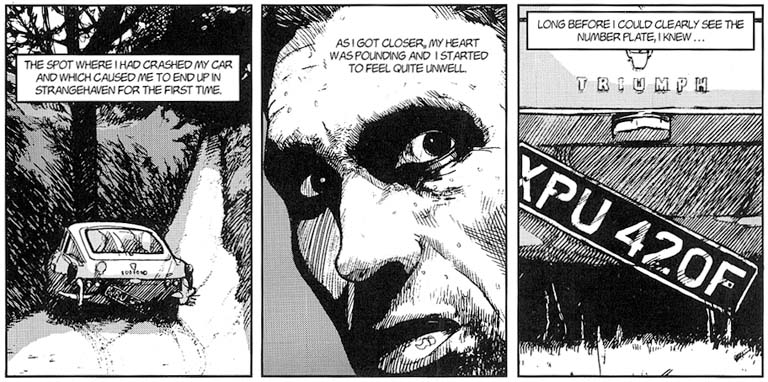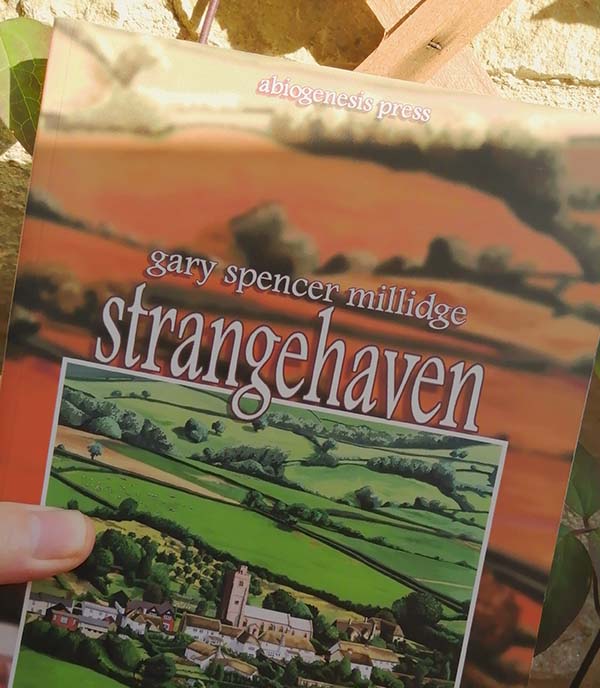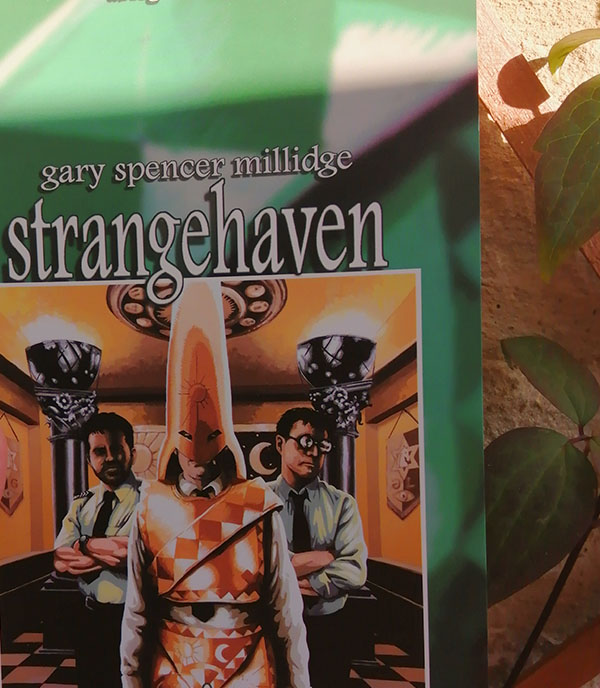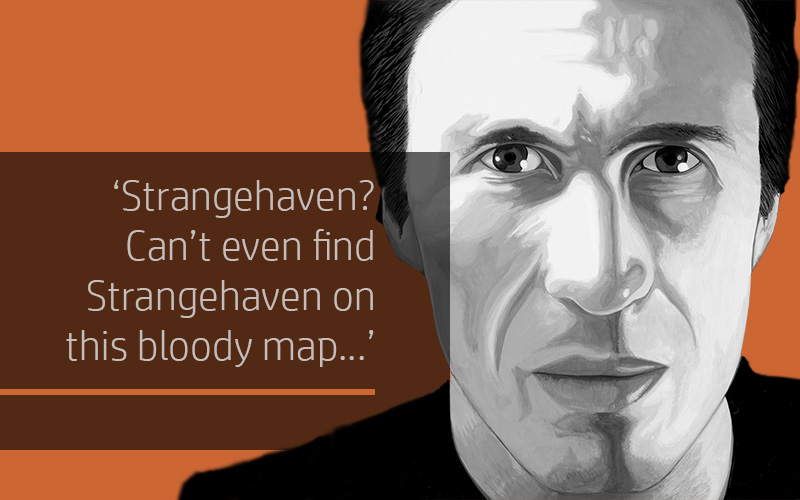
‘Strangehaven? Can’t even find Strangehaven on this bloody map…’
FROM THE HEADPRESS ARCHIVE
The train station at Leigh-On-Sea, on the Essex coast, is small and situated away from the town, like an airport of a much larger city, but with a gorgeous view that rolls into the North Sea.
The journey out from London passes quickly and I arrive earlier than anticipated. Now I sit with a mug of coffee in a Leigh-On-Sea train station café, waiting for Gary Spencer Millidge, creator, writer, illustrator and publisher of the comic book series Strangehaven.
A convoluting soap opera with magical elements, Strangehaven is an engaging and beautifully drawn collection of work that stands with the best of independent comics. The springboard for the story is Alex Hunter, who, following an accident, finds himself in Strangehaven, a village he cannot leave that is inhabited by curious, sometimes sinister individuals, not unlike those of the coastal town in which I presently find myself: I make a note to point Gary to several potential new Strangehaven characters in the thrall of Bargain Hunt, the daytime game show that happens to be playing on a television in the corner of the café. They are yelling at presenter Dave Dickinson.
Gary Spencer Millidge at the drawing board. Photo: David Kerekes

DAVID KEREKES: Was there any one spark that inspired Strangehaven?
GARY SPENCER MILLIDGE: It wasn’t one particular thing, but more of a combination of things. Strangehaven would have been my last big attempt at doing a comic book, and I wanted to do something that would enable me to do anything that I wanted to do. I think I was watching Twin Peaks at the time, and it struck me that the soap opera format had a lot of potential. I wanted to do something that incorporated all the different elements of why I enjoyed that fiction in general, so I drew in all my own influences. Such as The Prisoner.
How far ahead do you plot the series and how closely do you adhere to that plan?
When I did the first issue it was certainly the longest comics project I had attempted at the time, and I had probably only scripted about thirty-or-so pages of the comic itself up to that point. (The first issue came in at around thirty-two pages.) Although it was a soap opera, I was playing with the future leading into something and I couldn’t actually go any further than that. To a certain degree I was making it up as I went along. But by the time I came to the decision about collecting the issues into a trade paperback I was already planning ahead, so that the next trade paperback ended on some sort of climax, because the first one ended pretty much mid-strip. When I’d actually finished the second trade, which was the first twelve issues, I was thinking in terms of the general story overall.
At that time I actually got asked to do a movie treatment, which was a good discipline for me because it forced me to sit down and work everything out. Part of the attraction of Strangehaven isn’t that it’s got a traditional plot — it has a certain amount of ambiguity — but I sat down and worked everything out as though it had a traditional plot. Now I’ve written out to the end of book four (that’s scripted up to issue twenty-four).
The artwork changes quite dramatically as the issues progress.
When I did the first few issues I went back and re-read them, so before starting each new issue I re-read the preceding ones. Since I sat down and plotted all the issues I didn’t go back and re-read them until very recently. They do make me cringe now and you do learn a lot. I do make a huge effort because I knew it would be around for a long time. I did everything to make them as good as I possibly could. There’s no substitute for experience.
The early issues are perhaps more ‘clinical’ looking, while now you are using more shade and shadow. It’s interesting because it seems to be bringing the characters more to life.
A certain amount of that is just down to skill. I’d never used a dip-pen before the first issue; I used to use felt pen. And with issue seven — which turned out to be the start of book two, although I didn’t know that at the time — I bought a computer system to scan the artwork, purely because it was costing me so much money to send the original art over to America to the printers and back again. I thought there must be an easier way to do this, and so I bought a scanner. Then I discovered that I could probably do more than just scan the artwork, in fact the whole of the second book was just done in pencil and I worked on the pencils with the computer and also the lettering. At the time I thought that this would speed up production, but as it turned out, with the speed of computers back then, and spending time on elaborate toning, it worked out about the same. By the end of issue twelve I was fed up with sitting in front of the computer monitor. I wanted to go back and do as much by hand as possible.
Eventually I went back to traditional inking. It’s more fun to do although it really does take hours longer. No matter what technique you tend to use though, you can spend twelve, maybe sixteen hours on it.
Strangehaven trade paperback, Arcadia © Gary Spencer Millidge
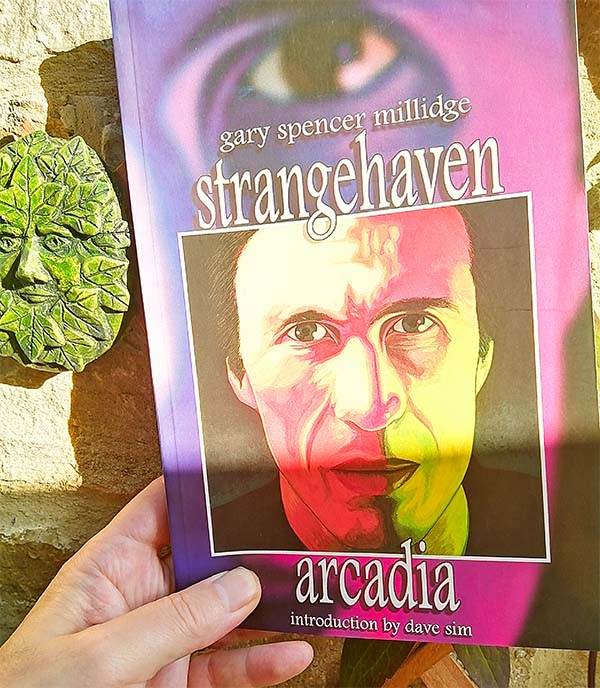
There was a letter from a reader in Strangehaven thirteen who said that he was fascinated by your portrayal of the English village (and the portrayal of English villages in the media in general). I like that.
I did research on small villages, and I’ve got couple of quotes on the back of early issues… I think one of the quotes I pulled out was ‘Behind an idyllic side of a West country village there lurks something darker’. This was just like a survey, and I did research for that and tried to incorporate things about Essex, and Essex villages and my own experiences of the West Country. And people regurgitate the prison of Twin Peaks, which helped to sell Strangehaven initially. I would also say The Darling Buds of May was a big influence. I always liked the fact that people draw this idyllic village — and the tax inspector went into Larkin’s house and ended up staying and marrying his daughter. It was that sort of draw that I wanted to give to Strangehaven, and also the film aspect.
You mention the ‘prison’ aspect of Strangehaven. You have made your influences plain by dropping references into the story.
Yes. The Prisoner and The Avengers. Also, what really inspired me to write the introduction, that cliché where Alex is driving down a dark road and crashes, is the Holding the Baby TV series. The whole show was always crap, but there’s always that eerie beginning. I always saw Strangehaven as constantly coming back to that point. It’s that sort of thing I wanted to capture.
Have you ever been tempted to publish a map of Strangehaven?
I’ve got a roughly drawn map. It isn’t in reference to any real place map. It’s probably impossible to be where it is, to drive to the coast without coming across any major roads. But for a map of the village itself, that’s under construction.
I didn’t anticipate your answer to that one. I thought you would probably have been against the whole map thing.
From a purely logistical point of view, when I draw a character walking up a road and he’s going from the pub to the post office, I want him facing the right direction. So I do work hard at those details. It’s not perfect. There are flaws.
You are basically a one-man operation. Can you tell us a bit about that?
I’ve always been interested in self-publishing. When I got back into the comics industry, I was thinking about getting together with a sympathetic publisher, but eventually I realised that was pretty much a non-starter. A guy called Paul Gravett — journalist, comics scene spokesperson and co-editor of Escape — said, “Why don’t you self-publish?” I just jumped in and started self-publishing. I needed a name and Abiogenesis was the first word I came across in the dictionary that hadn’t already been used — which was handy because it literally means ‘organic life from inorganic substances’.
What is your fan base like?
It seems very loyal and very resilient considering I’ve had scheduling problems over the last couple of years. My audience is very strong, and for a comic book has a strong female audience — twenty or thirty per cent. I would say it attracts people in their twenties to thirties, and a lot of people who publish as well, maybe supporting the whole idea of self-publishing.
You used to play in local rock bands. Does music inspire the way you draw?
No, not creatively. I still write songs and one day I’d like to do a project with art, comics and music — all my interests together — but I haven’t found enough common ground to justify it. I’ve probably been more ambitious in a marketing sense, because even in a band I started up my own record company, and now my own publishing company. I suppose I did both in order to maintain control of what I create. In terms of marketing, the music business is much harder to succeed in and that was proved to me by years of trying, whereas my first issue of Strangehaven got a write-up in the media.
Strangehaven © Gary Spencer Millidge
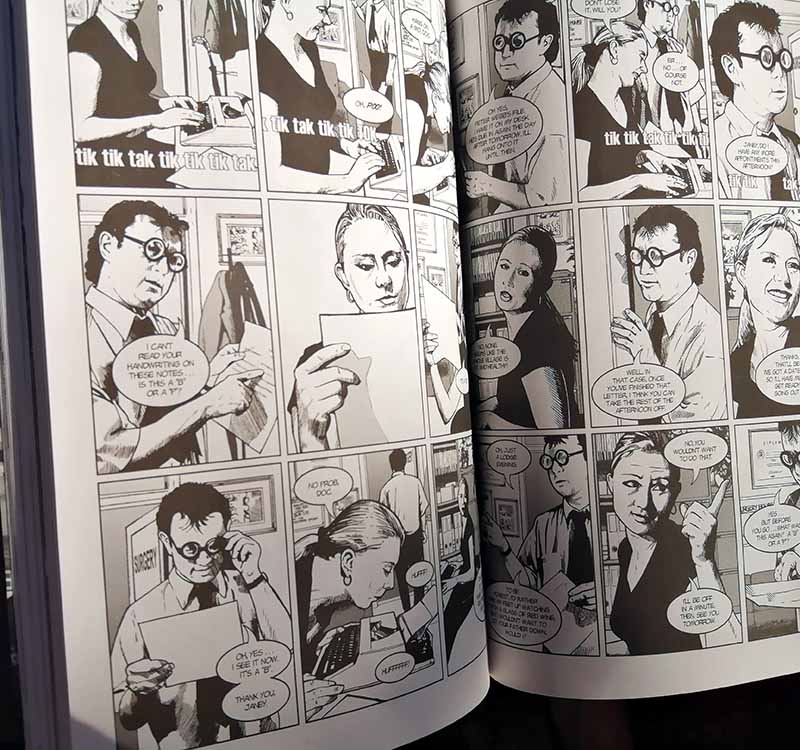
Can you tell me a little bit about the characters in Strangehaven? Do you model them on real people?
They’re not specific people. I think they’re more aspects of my own personality. What I’m really interested in doing in Strangehaven is looking at individuals’ perceptions of the world about them.
You’ve got otherwise ordinary characters that generally seem to have this underlying sinister side to their personality or some weird trait…
One of the things I’ve taken from early episodes of The Avengers and Twin Peaks is the ambiguity. If it’s done in the right way you don’t really want to know what’s behind these traits; part of the attraction is the mystery. But of course you’ve got to be careful not to be just strange, and whether I explain everything fully in the book or not there’s an underlying thought behind it and whatever is portrayed as the truth in Strangehaven is only someone’s perception.
Do you use pro models?
No, they are friends and family. When Strangehaven’s finished — which will be a tremendous relief — I will probably change my methods. Maybe I will use professional models.
You’ve got Basil Fawlty in a dialogue with one of the characters in one issue. I’ve got to admit, I thought that the character of Meg at first was supposed to be David Hockney, the artist, and I said to myself, “Ah, I know where this is going!” I was wrong of course.
Interesting. Meg wasn’t consciously modelled on David Hockney.
How do you go about shaping the characters?
Although I use photographic models to actually draw them, I’m always very careful to write the character first. I’m very careful to write characters, some are just function characters, while others are more ‘way out’ characters that are crucial to the plot. I think that using photographic models probably adds another dimension in terms of body language, which helps round out these characters.
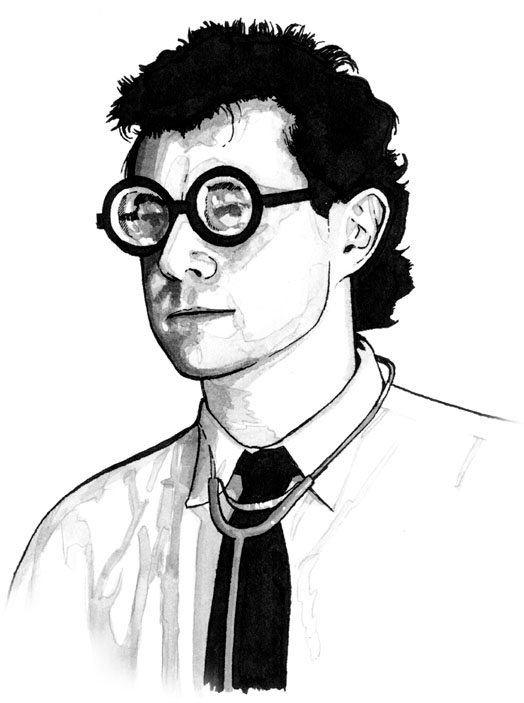
The Doctor 
Alex

Adam and Ronnie 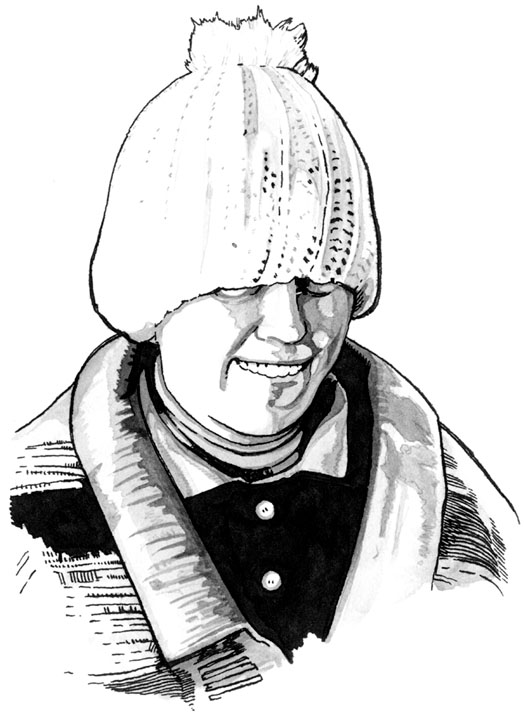
Elsie
How do you see Strangehaven ending?
I see an end at least in a temporary sense. I’ve written it to a climax. The length of time it has taken me to write, there are other things I want to do, and even though I said I wanted to do something that would allow me to do anything within a certain format, it turned out that there are certain things that I want to do that I can’t fit in. So you are probably looking at starting a new magazine. I’ll continue with Strangehaven in some way, but there are a number of prospects I can’t fit in at the moment.
What makes the early issues different is that they’re fairly chaotic — they go off on tangents. A number of readers are intimidated by the tangents because it is getting away from the plot, although I tried to introduce other stories — Alex and his relationship with Jane, for instance — but I also think it’s the tangents that make Strangehaven unique.
Do you ever get to a point where you think ‘I wish I hadn’t done that because now I can’t do this?’
No. I think every creator can go back and revise their work, but I don’t necessarily think it would be any the better for it. I could certainly brush up the early issues, and I did to a very minimal extent for the trade paperback; I just fixed one or two things. I sat down and looked at a calendar because there were too many full moons in one issue for the length of time it covered. Things like that I tried to fix. It could have been even better if I’d sat down and worked every letter out, but it would have lost some of the spontaneity. But out of that has grown this massive single plot where everything’s connected, and it can be quite a headache to try and get all the events happening in the right order and still produce a balanced twenty-four-page comic.
Strangehaven © Gary Spencer Millidge
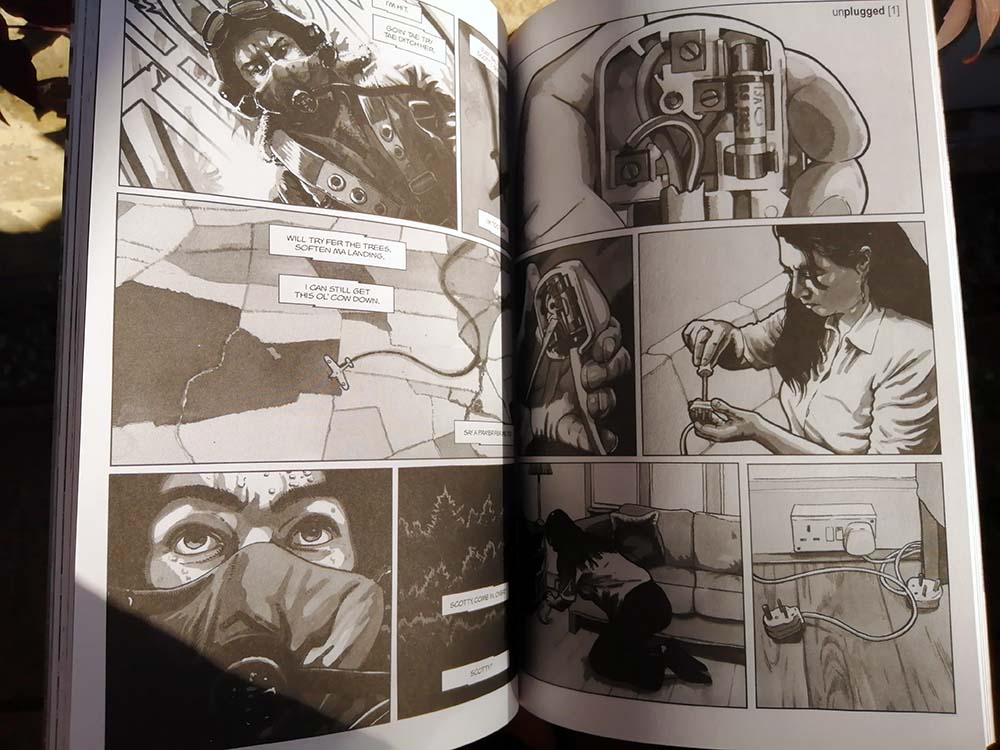
You’ve got so many different things going on in Strangehaven and everything seems to be driven by its own agenda, but also by what seems to be some kind of supernatural thing.
There is an underlying supernatural theme there, but with all my research I try to be very accurate and with anything supernatural I try to base it on peoples’ genuine supernatural beliefs, so I’m not just pulling it out of thin air. I’m trying to give alternative explanations for events; maybe it’s supernatural, maybe it’s not, it all depends on whether you believe in that. But the more I research into things like that, the more difficult it is to make anything convincing out of it. When I was eighteen, I was into astrology — I’ve probably got a dozen books on the subject. As you get older your appreciation for the unexplained wanes a bit, and I’ve probably become more interested in telling the story of relationships.
So, Alex being unable to leave the village may be down to something mundane like the fact that he’s hopeless with geography?
I think this is an example where the end has to be left ambiguous. That concept was not so much based on The Prisoner, but more of a magical thing where all roads lead there. It’s a sort of gateway. One of my earliest memories is of going to Hampton Court with my parents and walking around a maze. I remember seeing the entrance to it, and I knew the entrance was there and I could see the way out, but there was a door that was made into a part of the bush wall, so you’d go into the maze, and they’d shut the door. Strangehaven is a bit like that: there’s a sort of trick going on there. It’s got to be a mystical, magical place — that is central to the idea. It’s somewhere where people go to meet their destiny.
Addendum
This interview originally appeared in a slightly different form in Headpress 26 (2005). At the time the interview was conducted, Strangehaven – on an irregular publishing schedule due to other commitments – had entered an extended hiatus. In 2014, new (colour) episodes began to appear in the comics anthology, Meanwhile… from Soaring Penguin Press.
Anyone missing the original run from the 1990s could do a lot worse than pick up Gary’s self-published trade paperbacks, Arcadia, Brotherhood and Conspiracies, collecting Strangehaven issues one through eighteen.
Anyone wishing to join the Gary Spencer Millidge Newsletter, go here.
David Kerekes
Like this article?
Related Posts
Comments
Copyright © Headpress

